陈菊ju Unit 4 Time 教学设计
七年级英语下册人教版Unit4第4课时SectionB2a2c教学设计

(三)学生小组讨论
1.教师将学生分成小组,每组选择一个人物进行讨论,描述其特点、经历和成功原因。
2.学生运用本课时所学词汇和语法结构进行讨论,教师巡回指导,给予反馈。
3.各小组展示讨论成果,其他小组进行评价,教师总结并进行点评。
4.教师鼓励学生在讨论中积极参与,提高口语表达能力。
1.通过图片、实物等直观教具,帮助学生理解和记忆新词汇。
2.采用任务型教学法,设置各种真实的语境,让学生在实际运用中掌握语法知识。
3.利用听力材料,引导学生进行听前预测、听中关注、听后总结,提高听力理解能力。
4.创设情境,鼓励学生积极参与口语交流,提高口语表达能力。
5.引导学生运用阅读策略,如略读、寻读、精读等,提高阅读理解能力。
在本章节的学习中,学生需要在教师的引导下,通过生动有趣的课堂活动,进一步巩固和拓展词汇、语法知识。在听力方面,学生需要提高对细节信息的捕捉能力和对整体语境的理解能力。口语交流方面,学生已经具备初步的对话能力,但表达尚不够流畅,需要教师在课堂上给予更多鼓励和指导。
此外,学生在情感态度与价值观方面,正处于青春期,对自我认知和他人评价较为敏感。因此,在本章节的教学中,教师应关注学生的情感需求,引导他们树立正确的价值观,培养积极向上的心态。通过本章节的学习,使学生能够在英语学习中不断提高自己,为未来的成长奠定坚实基础。
(四)课堂练习
1.教师设计一系列练习题,包括词汇填空、语法改错、听力选择等,让学生巩固所学知识。
2.学生独立完成练习题,教师对答案进行讲解,针对学生错误进行指导。
3.教师挑选部分练习题进行课堂讲解,帮助学生理解解题思路。
4.学生进行互评,提高自我纠错能力。
三年级英语Unit4 Time PartB导学案
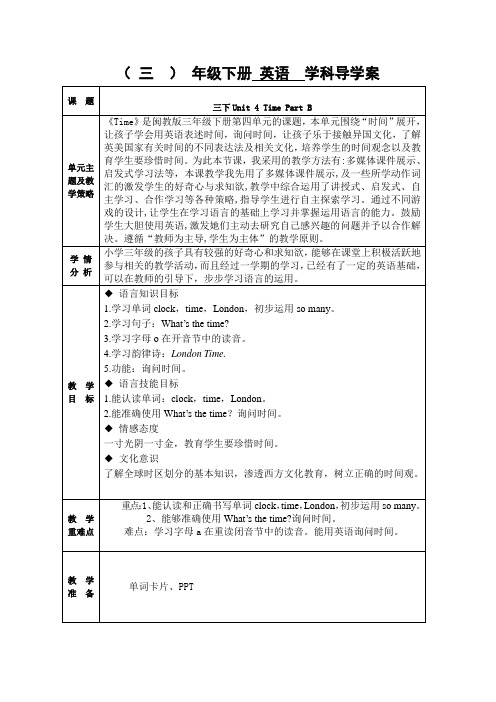
(三)年级下册英语学科导学案板书句子What’s the time?并教学。
(4)游戏——走走停停看时间。
游戏规则:教师拿着卡通纸板钟绕着班级走,边走边拨动钟面。
全班学生不间断地提问:“What’s the time?”教师在一位学生面前停下,这位学生就要接过卡通纸板钟,看着钟回答:“It’s...o’clock.”答对的学生所在的小组得分。
(5)文化渗透。
普及全球时区划分的基本知识,树立正确的时间观。
(二)课文教学1.教授句子:It’s eleven o’clock in Beijing.和It’s three o’clock in London. (1)教师指着黑板上标有Beijing的钟面,对学生说:“It’s eleven o’clock in Beijing.”板书句子并教学。
(2)教师指着黑板上标有London的钟面,对学生说:“It’s three o’clock in London.”板书句子并教学。
2.请全班翻开课本第25页,教师播放课文录音,学生跟着录音模仿说句子。
3.再播放课文录音二到三遍,采用全班学生跟读、个别学生或小组跟读的形式学习对话内容。
(三)语音教学1.复习字母o在重读闭音节中的读音。
(1)教师播放课本第24页第3部分的录音,让学生跟读单词dog,stop,pencil-box,引出字母o发/D/的音。
(2)教师出示单词dog,stop和pencil-box,由学生自主拼读。
2.学习字母o在开音节中的读音。
(1)教师出示单词no,让学生感知单词no中字母o的读音,引出字母o 发//音的教学。
(2)教师出示单词go,nose和home,学生尝试拼读。
(3)请学生翻开课本第26页,教师播放录音,学生模仿跟读。
3.游戏——耳力大比拼。
游戏规则:教师将dog, stop, pencil-box, go, nose和home六个单词随机两两配对,并朗读,让学生判断字母o在这两个单词中的读音是否相同。
Unit 4 Time Lesson 3 教案新部编本 2
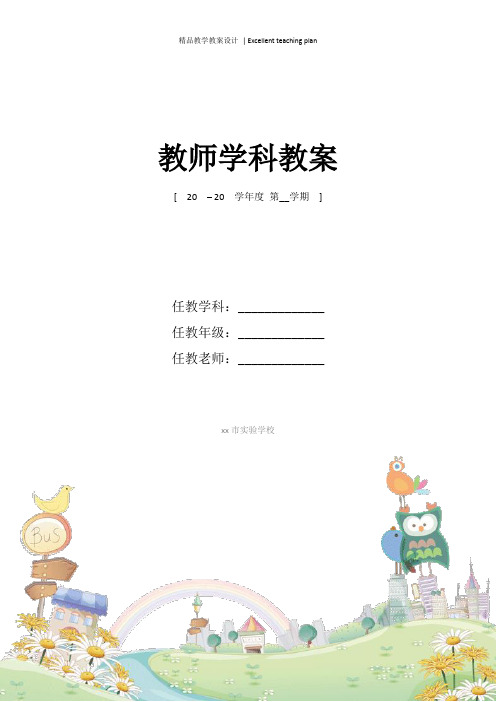
教师学科教案[ 20 – 20 学年度第__学期]任教学科:_____________任教年级:_____________任教老师:_____________xx市实验学校Unit 4 Time Lesson 3教案 2教学内容:◆学生能将单词和词组的音和相应的图形联系起来,并能看图用英文说出单词◆通过简单的形体姿势来表示时间◆学生通过活动、练习、巩固时间的表达,以及钟表上时针分针的相对应的位置教学目标:◆认知目标:✧能听说认读与时间有关的单词✧能灵活运用It’s time for…来表达到什么时间该做什么事情了◆情感目标:✧学生能够通过对本课时间表达的学习提高对时间的认识,学会爱惜时间、珍惜时间。
✧能够在学习的过程中增强自己的生活能力。
◆学习策略目标:✧培养学生的注意力、观察力,激发学生积极思维。
✧通过小组活动,培养学生积极与他人合作,共同完成学习任务。
✧在任务中,引导学生积极运用所学英语进行表达与交流。
教学重点:◆与时间有关的单词:o’clock breakfast lunch supper time◆学会表达几点教学难点:单词的发音以及钟表整点时间的英文表达教学准备:教学挂图,教学投影片,教学录音磁带,单词卡片,钟表模型,分针与时针的模型。
教学步骤:step 1. warming up (热身活动)✧手指数字游戏(师说十以内数字,学生用出示手指来表示)step 2. presentation✧T: What can you hear? Listen!S1: The bell.T: Yes, the sound is from the clock.Today, we’ll learn time.-----time (出示卡片,讲授单词)✧T: Do you know how to tell others the time?Look! It’s seven o’clock..(七时) ----- o’clock (出示卡片,讲授单词) I’m hungry. It’s time for breakfast. I want to have something to eat.------ It’s time for breakfast.✧T: Now, look! (拨到十二时)Ss: It’s 12.T: It’s 12 o’clock.----- o’clockI’m hungry. It’s time for lunch.------ It’s time for lunch.✧T: Now, what’s the time? (拨到6时)Ss: It’s 6 o’clock.T: Yes, it’s 6 o’clock. It’s time for supper.------ It’s time for supper.✧Learn a chant1) Listen to the chantSixty seconds in a minute!Sixty minutes in an hour!Twenty four hours in a dayThe time tick away.Sixty minutes in an hour!Twenty four hours makes a day.What time is it? What time is it?Time to eat and time to play.2) Follow the chantstep 3. practicing (操练)✧Pair workT: Now, you can adjust your clock, practice the 3 different time and say “It’s timefor….”✧Practice other different timeWhat time is it?It’s . It’s time for.✧Show some pairs’ jobsstep 3. summary (小结)✧今天学习了有关时间的词汇:o’clock breakfast lunch supper time✧学习了常用的有关时间的交际用语:What time is it? It’s . It’s time for.并能运用所学知识进行回答。
Unit 4 Free Time 教案
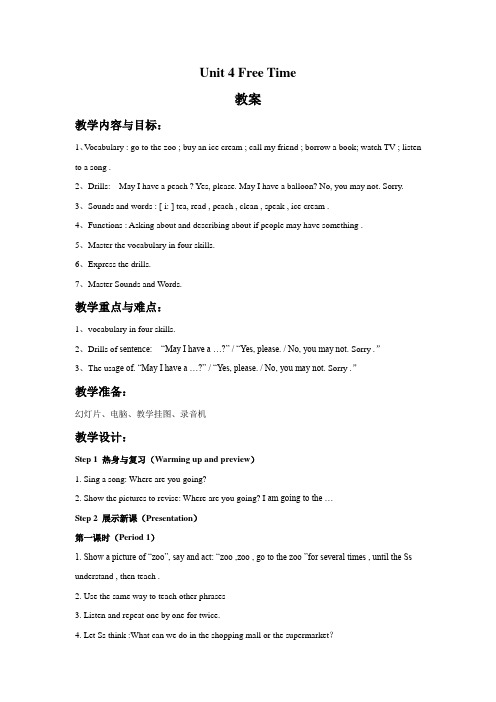
Unit 4 Free Time教案教学内容与目标:1、Vocabulary : go to the zoo ; buy an ice cream ; call my friend ; borrow a book; watch TV ; listen to a song .2、Drills: May I have a peach ? Yes, please. May I have a balloon? No, you may not. Sorry.3、Sounds and words : [ i: ] tea, read , peach , clean , speak , ice cream .4、Functions : Asking about and describing about if people may have something .5、Master the vocabulary in four skills.6、Express the drills.7、Master Sounds and Words.教学重点与难点:1、vocabulary in four skills.2、Drills of sentence: “May I have a …?” / “Yes, please. / No, you may not. Sorry .”3、The usa ge of. “May I have a …?” / “Yes, please. / No, you may not. Sorry .”教学准备:幻灯片、电脑、教学挂图、录音机教学设计:Step 1 热身与复习(Warming up and preview)1. Sing a song: Where are you going?2. Show the pictures to revise: Where are you going? I am going to the …Step 2 展示新课(Presentation)第一课时(Period 1)1. Show a picture of “zoo”, say and act: “zoo ,zoo , go to the zoo ”for several times , until the Ss understand , then teach .2. Use the same way to teach other phrases3. Listen and repeat one by one for twice.4. Let Ss think :What can we do in the shopping mall or the supermarket?5. Make a situation for shopping .The teacher self- directed and performed , and lead out the new sentence structures: “May I have a …?” / “Yes , please .”6. Let someone come to the platform and help teacher make dialogues.7. Practice more and lead out the different ans wer: “ No, you may not . Sorry.”第二课时(Period 2)1. Let Ss think :What can we do in the shopping mall or the supermarket ?2. Make a situation for shopping .The teacher self- directed and performed,and lead out the new sentence struc tures: “May I have a …?” / “Yes, please.”3. Let someone come to the platform and help teacher make dialogues.4. Practice more and lead out the different ans wer: “No, you may not . Sorry.”第三课时(Period 3)(一) Pre-reading1、Revise the new words altogether.2. Use the pictures to revise: May I have a peach? Yes, please. May I have a balloon? No, you may not. Sorry.(二) While-reading1. Read the Story seriously and try to catch the main point and find out the new sentences in it.2. Guess and teach the new sentences.3. Let the pupils look at the Story while listening to the tape.4. Use the mood of telling story, the teacher repeat the conversation and help them to understand the content.5. Explain the language structures.6. Listen and repeat several times.(三) Post –reading1. Read for role acting.2. Answer some questions according to the Story.Step 3 练习(Practice)1. Look and say. The teacher show of the picture and Ss say out the phrase such as: book , book, borrow a book.2. Do pair work like this.3. Listen and show. The teacher says one of the phrase and Ss show out the right work card.4. Do work by the same way.5. Have Ss look and read the sentences in Practice 1 and try to catch the meanings.6. Listen and circle the right sentences.7. Listen again and check the answers.8. Listen and repeat one sentence by one sentence.9. Have Ss read the questions in Practice 2 and try to answer by the checking.10. Make more dialogues according to the pictures under the questions.第四课时(Period 4)1. Show pictures of “peach” and “ice cream”, let Ss r ead loudly.2. Read several times and catch the pronunciation of “ea”.3. Let Ss look at the teacher’s mouth, then teach them say [i:]4. Show other pictures and lead them readout the new words correctly.5. Teach them read: [i:] [i:]tea , [i:] [i:]6. Sum up the sound of [i:] in these words.Step 4 小结(Summary)1. Look at the book and read the phrases together.2. Match the pictures to the right phrases in Activity 1.Step 5 家庭作业(Homework)1. Recite and copy the new phrases.2. Recite and act the Story in pairs outside class.3. Make more dialogues just like the dialogue in the Activity 2.。
Unit 4 Time Part A 教案1-优质公开课-闽教三起3下精品
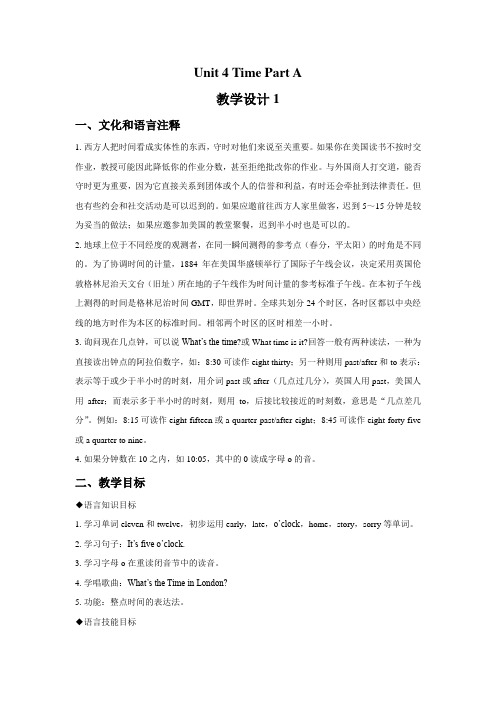
Unit 4 Time Part A教学设计1一、文化和语言注释1.西方人把时间看成实体性的东西,守时对他们来说至关重要。
如果你在美国读书不按时交作业,教授可能因此降低你的作业分数,甚至拒绝批改你的作业。
与外国商人打交道,能否守时更为重要,因为它直接关系到团体或个人的信誉和利益,有时还会牵扯到法律责任。
但也有些约会和社交活动是可以迟到的。
如果应邀前往西方人家里做客,迟到5~15分钟是较为妥当的做法;如果应邀参加美国的教堂聚餐,迟到半小时也是可以的。
2.地球上位于不同经度的观测者,在同一瞬间测得的参考点(春分,平太阳)的时角是不同的。
为了协调时间的计量,1884年在美国华盛顿举行了国际子午线会议,决定采用英国伦敦格林尼治天文台(旧址)所在地的子午线作为时间计量的参考标准子午线。
在本初子午线上测得的时间是格林尼治时间GMT,即世界时。
全球共划分24个时区,各时区都以中央经线的地方时作为本区的标准时间。
相邻两个时区的区时相差一小时。
3.询问现在几点钟,可以说What’s the time?或What time is it?回答一般有两种读法,一种为直接读出钟点的阿拉伯数字,如:8:30可读作eight thirty;另一种则用past/after和to表示:表示等于或少于半小时的时刻,用介词past或after(几点过几分),英国人用past,美国人用after;而表示多于半小时的时刻,则用to,后接比较接近的时刻数,意思是“几点差几分”。
例如:8:15可读作eight fifteen或a quarter past/after eight;8:45可读作eight forty five 或a quarter to nine。
4.如果分钟数在10之内,如10:05,其中的0读成字母o的音。
二、教学目标◆语言知识目标1.学习单词eleven和twelve,初步运用early,late,o’clock,home,story,sorry等单词。
Unit 4 Time教案20

Unit 4 Time本次授课我执教了人教版新起点第4册Unit4 time的第一课时,主要是让学生学习和掌握六个数词eleven, twelve, twenty, thirty, forty, fifty。
能在熟悉钟面的基础上,用It’s.... 表达时间。
本课的教学对象是二年级学生,此阶段的学生天真活泼、好奇心强、有较强的模仿能力和求知欲望。
上课伊始,我首先采用一贯的歌曲热身,然后用歌曲复习数字,用数字零来变一变,画出钟面,引起学生的好奇,激起学生学习的兴趣,继而让学生熟练说说钟面的表达方法。
本课中的单词教学是重点也是难点,对于七个新单词的教学我采用了自然拼读法,利用汉语拼音的读法帮助学生识记单词,让学生关注字母及字母组合的发音,如TH ,IR,与TY的字母组合读音。
当然这种方法是从一年级就开始渗透的,也取得了一些效果。
还有忆旧词识新词的教学方法,如:ELEVEN 和SEVEN,THIRTY 和THIRSTY让学生自己读出单词的读音等。
根据学生的特点,激发学生的兴趣和参与意识,采用“闪图猜词,读一读,画一画,“看单词的收尾字母认单词等多种活动进行单词的练习和巩固,为了体现英语教学的实用性我通过美羊羊闯关游戏检查学生的学习效果,在此部分,按照听说读的顺序安排了游戏内容,让学生在学中用,用中学,体现英语的真实情境性。
让学生在宽松的氛围中体验到英语学习的兴趣,使英语学习显得不那么枯燥。
回顾自己上的观摩课,知道自己的课堂教学中存在很多值得反思之处,现总结如下:1、自然拼读法还是很有用,以后的教学要继续总结,帮助学生更好的记忆单词。
2、游戏操作过程有点凌乱。
本节课我采用的游戏方法确实很多,可谓五花八门,但在实际运用过程中并没有很好地把握好,没有做到面向全体学生,游戏时间也没有控制好。
3,由于本人是急性子,学生稍有点反应迟缓,我就开始心急,导致没有给学生过多的思考时间,教学仓促,效果没有达到最佳。
总而言之,需要学习的东西还有很多,关键是要懂得汲取经验,取长补短,不断努力,不断创新,不断学习,不断进步,不断突破。
三年 级 英语下册 Unit 4 Time Part A说课稿
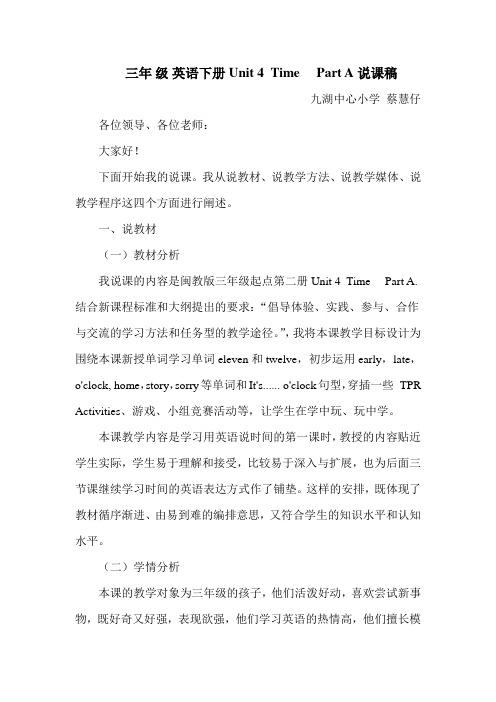
三年级英语下册 Unit 4 Time Part A说课稿九湖中心小学蔡慧仔各位领导、各位老师:大家好!下面开始我的说课。
我从说教材、说教学方法、说教学媒体、说教学程序这四个方面进行阐述。
一、说教材(一)教材分析我说课的内容是闽教版三年级起点第二册Unit 4 Time Part A. 结合新课程标准和大纲提出的要求:“倡导体验、实践、参与、合作与交流的学习方法和任务型的教学途径。
”,我将本课教学目标设计为围绕本课新授单词学习单词eleven和twelve,初步运用early,late,o'clock, home,story,sorry等单词和It's...... o'clock句型,穿插一些TPR Activities、游戏、小组竞赛活动等,让学生在学中玩、玩中学。
本课教学内容是学习用英语说时间的第一课时,教授的内容贴近学生实际,学生易于理解和接受,比较易于深入与扩展,也为后面三节课继续学习时间的英语表达方式作了铺垫。
这样的安排,既体现了教材循序渐进、由易到难的编排意思,又符合学生的知识水平和认知水平。
(二)学情分析本课的教学对象为三年级的孩子,他们活泼好动,喜欢尝试新事物,既好奇又好强,表现欲强,他们学习英语的热情高,他们擅长模仿,擅长于具体形象思维,乐于表演,但有注意力不持久、不稳定的特点。
孩子们有与他人合作、交流的意愿。
学生从三年级上学期开始学英语,对数字、家庭成员、水果、食物等英语单词掌握较牢固,能用简单的英语进行交流,能根据指令做游戏做事情,从而为下一步的学习打下良好的基础。
(三)教学目标新课程强调知识与技能、过程与方法、情感态度与价值观三个角度的有机结合,本着这样的认识,我制定如下教学目标。
◆语言知识目标1.学习单词eleven和twelve,初步运用early,late,o'clock, home,story,sorry等单词。
2.学习句子:It's five o'clock.3.功能:整点时间的表达法。
Unit4第4课时(SectionB2a2c)教学设计七年级英语上册(人教新目标Goforit!)
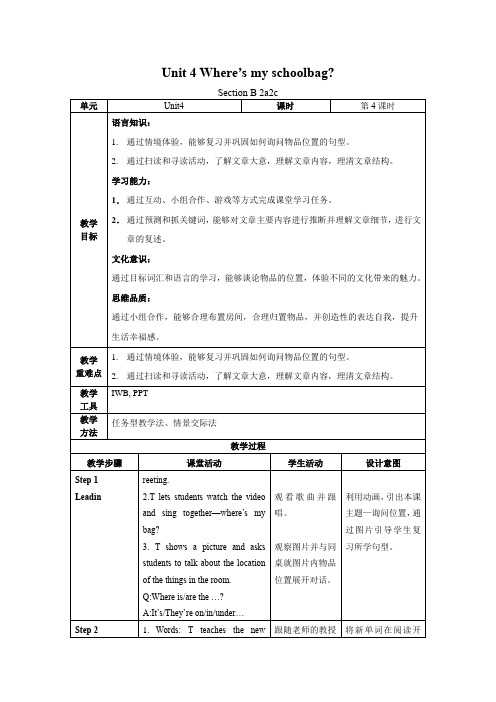
Q:Where is/are the …?
A:It’s/They’re on/in/under…
观看歌曲并跟唱。
观察图片并与同桌就图片内物品位置展开对话。
将家庭作业做好记录。
检查学习效果,加深对知识的理解和记忆。
板书设计:
New words
Writing
but,everywhere,always,our,tidy
In my room,my dictionary and my radio are on the desk.
My pencil box is in my schoolbag and my schoolbag is under the desk.
跟随老师的教授学习新单词的发音,释义,词组搭配和例句。
完成书本2a部分的任务。
根据2a部分图片,进行游戏,同学说出物品名称,迅速接出该物品位置的介词短语。
观察2b部分的人物照片,展开预测并回答以下三个问题。
将新单词在阅读开始之前教授,扫清单词障碍,使阅读更流畅。
通过已学内容的图片,引导学生进行回顾,整合单元物品词汇,为阅读打好基础。
4.T shows the picture in 2b and asks students to predict:
Q1:Who are the two girls?
Q2:What’s the relationship(关系) between them?
Q3:What will the passage talk about?
人教新起点三年级下册英语-Unit4FullTime教案
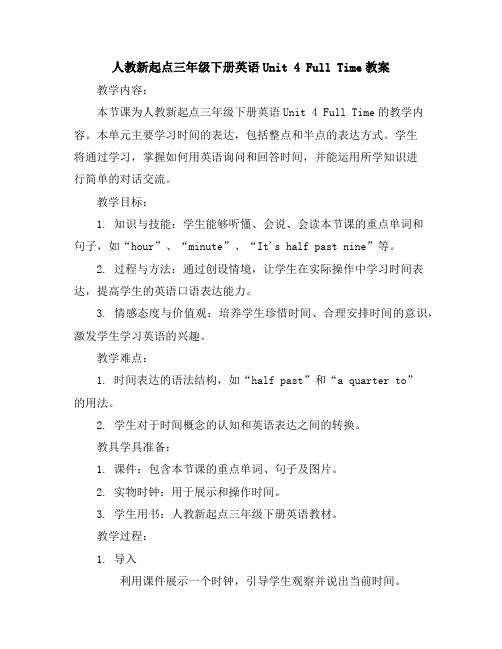
人教新起点三年级下册英语Unit 4 Full Time教案教学内容:本节课为人教新起点三年级下册英语Unit 4 Full Time的教学内容。
本单元主要学习时间的表达,包括整点和半点的表达方式。
学生将通过学习,掌握如何用英语询问和回答时间,并能运用所学知识进行简单的对话交流。
教学目标:1. 知识与技能:学生能够听懂、会说、会读本节课的重点单词和句子,如“hour”、“minute”、“It's half past nine”等。
2. 过程与方法:通过创设情境,让学生在实际操作中学习时间表达,提高学生的英语口语表达能力。
3. 情感态度与价值观:培养学生珍惜时间、合理安排时间的意识,激发学生学习英语的兴趣。
教学难点:1. 时间表达的语法结构,如“half past”和“a quarter to”的用法。
2. 学生对于时间概念的认知和英语表达之间的转换。
教具学具准备:1. 课件:包含本节课的重点单词、句子及图片。
2. 实物时钟:用于展示和操作时间。
3. 学生用书:人教新起点三年级下册英语教材。
教学过程:1. 导入利用课件展示一个时钟,引导学生观察并说出当前时间。
通过问答形式复习上一节课学过的内容,为新课做好铺垫。
2. 新课展示利用课件展示本节课的重点单词和句子,引导学生跟读并模仿。
通过实物时钟操作,让学生亲身体验时间的变化,加深对时间表达的理解。
3. 情境练习创设情境,让学生在模拟的日常生活场景中运用所学知识进行对话练习。
鼓励学生相互交流,提高口语表达能力。
4. 巩固拓展利用课件进行听力练习,巩固本节课所学内容。
设计游戏环节,让学生在轻松愉快的氛围中复习时间表达。
针对学生的回答进行点评和指导,纠正发音和语法错误。
板书设计:1. 人教新起点三年级下册英语Unit 4 Full Time2. 重点单词:hour、minute、half past、a quarter to3. 重点句子:It's half past nine. It's a quarter to twelve.4. 时间表达的结构:hour + "o'clock"(整点),hour + "thirty"(半点),hour + "fortyfive"(差十五分到整点)作业设计:1. 听力练习:完成教材P36的听力练习。
教学设计-unit-4--time
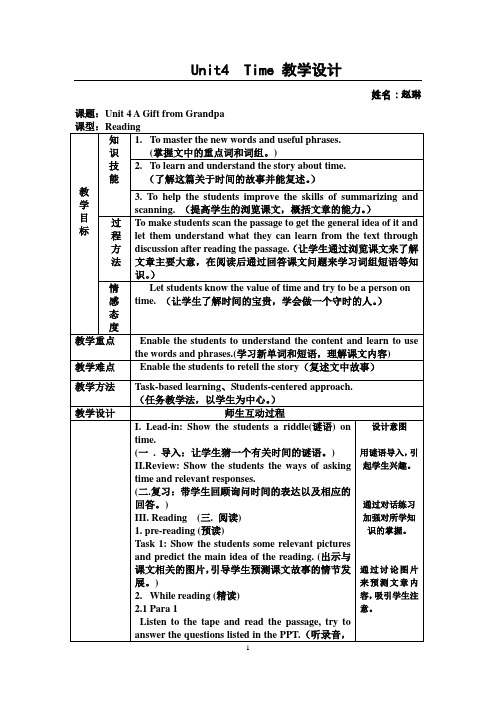
Unit4 Time 教学设计姓名:赵琳课题:Unit 4 A Gift from Grandpa附:课文原文A Gift from GrandpaOne day my father said to me , “Your grandpa is coming by plane to see us tomorrow, will you please get to the airport at nine thirty in the morning to meet your grandpa on time?” I was very glad to hear this because I was looking forward to seeing my grandpa. “OK. No problem. ” I answered. “I will get to the airport before 9:30. Don’t worry.”The next morning, I got up very early. I had enough time to do something before leaving for the airport. So I played a computer game on line with my e-pal. When we were playing in great joy, I suddenly remembered my grandpa. My God! It was already 10 o’clock. How terrible it was!I hurried to the airport, but I was two hours late. Where to find my grandpa?It was lunch time when I got home. I found my grandpa was talking with my parents at home. My grandpa was delighted when he saw me and said, “Hi, my dear grandson. I know you are busy with your work and study. So I took a taxi to come here from the airport.” I was too ashamed to say a word. My father looked very angry. My grandpa asked me to sit next to him. “Here is a small gift for you,”he gave his old watch to me and said, “It can tell you what time is.”People usually say time is money. But this watch tells me more than that. No matter what to do, just do it on time. Yes, I will remember. “Thank you, Grandpa.”。
Unit 4 Free Time教案
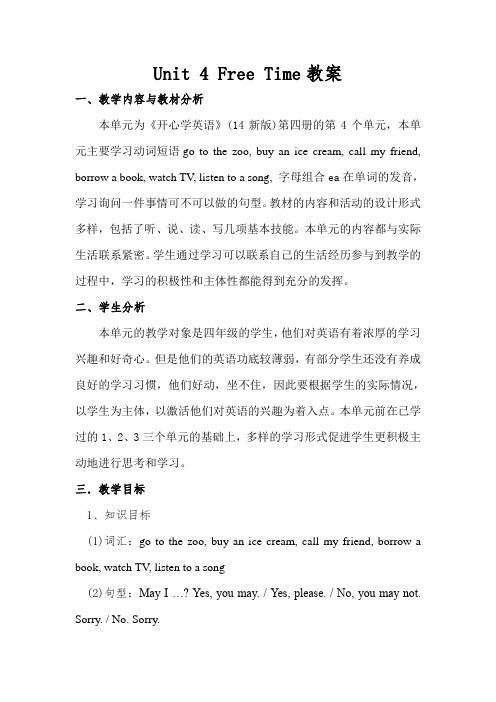
Unit 4 Free Time教案一、教学内容与教材分析本单元为《开心学英语》(14新版)第四册的第4个单元,本单元主要学习动词短语go to the zoo, buy an ice cream, call my friend, borrow a book, watch TV, listen to a song, 字母组合ea在单词的发音,学习询问一件事情可不可以做的句型。
教材的内容和活动的设计形式多样,包括了听、说、读、写几项基本技能。
本单元的内容都与实际生活联系紧密。
学生通过学习可以联系自己的生活经历参与到教学的过程中,学习的积极性和主体性都能得到充分的发挥。
二、学生分析本单元的教学对象是四年级的学生,他们对英语有着浓厚的学习兴趣和好奇心。
但是他们的英语功底较薄弱,有部分学生还没有养成良好的学习习惯,他们好动,坐不住,因此要根据学生的实际情况,以学生为主体,以激活他们对英语的兴趣为着入点。
本单元前在已学过的1、2、3三个单元的基础上,多样的学习形式促进学生更积极主动地进行思考和学习。
三.教学目标1、知识目标(1)词汇:go to the zoo, buy an ice cream, call my friend, borrow a book, watch TV, listen to a song(2)句型:May I …? Yes, you may. / Yes, please. / No, you may not. Sorry. / No. Sorry.Here you are! Thank you. You’re welcome.(3)字母ea及它们在单词tea, read, peach, clean, speak, ice cream中的发音。
2、能力目标(1)通过学习,使学生能掌握和运用本单元的单词和句型。
(2)提高学生把所学知识运用到生活的情景中的能力。
3、情感目标(1)在学习的同时,教育孩子们在做事情的时候要学会尊重别人和学会在做事情之前要询问一下可不可以做,时刻注意安全,学会保护自己和别人。
Unit4_第4课时教学设计
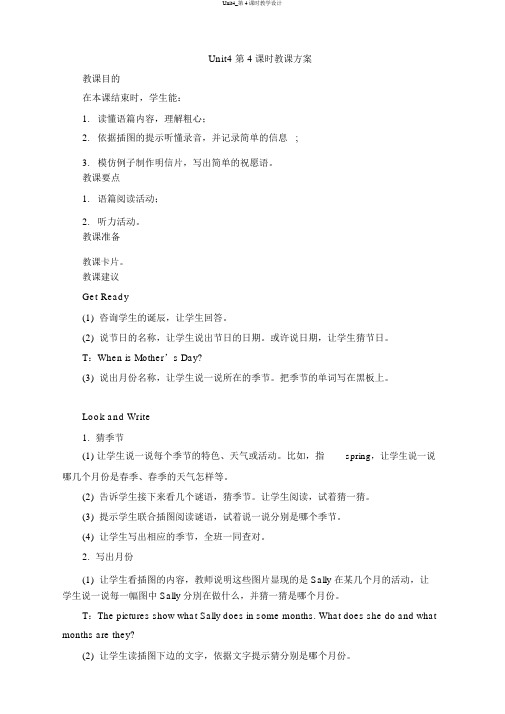
Unit4 第 4 课时教课方案教课目的在本课结束时,学生能:1.读懂语篇内容,理解粗心;2.依据插图的提示听懂录音,并记录简单的信息 ;3.模仿例子制作明信片,写出简单的祝愿语。
教课要点1.语篇阅读活动;2.听力活动。
教课准备教课卡片。
教课建议Get Ready(1)咨询学生的诞辰,让学生回答。
(2)说节日的名称,让学生说出节日的日期。
或许说日期,让学生猜节日。
T:When is Mother’s Day?(3)说出月份名称,让学生说一说所在的季节。
把季节的单词写在黑板上。
Look and Write1.猜季节(1) 让学生说一说每个季节的特色、天气或活动。
比如,指spring,让学生说一说哪几个月份是春季、春季的天气怎样等。
(2)告诉学生接下来看几个谜语,猜季节。
让学生阅读,试着猜一猜。
(3)提示学生联合插图阅读谜语,试着说一说分别是哪个季节。
(4)让学生写出相应的季节,全班一同查对。
2.写出月份(1)让学生看插图的内容,教师说明这些图片显现的是 Sally 在某几个月的活动,让学生说一说每一幅图中 Sally 分別在做什么,并猜一猜是哪个月份。
T:The pictures show what Sally does in some months. What does she do and what months are they?(2)让学生读插图下边的文字,依据文字提示猜分别是哪个月份。
(3)让学生说一说他们的猜想,全班一同查对答案。
Listen and Write(1)让学生看页面上的学生卡,告诉学生接下来听录音,需要他们补全学生卡上所缺的信息。
(2)让学生看学生卡内容,猜一猜所缺的内容是什么。
(3)播放录音,让学生完好听一遍,能够边听边记录。
(4)再次播放录音,能够每次播放一张学生卡的内容,让学生记录所缺信息。
(5)采纳师生问答的方式查对达成状况,播放录音让学生查对。
能够让学生跟读录音内容。
陈菊juUnit4Time教学设计最新

陈菊juUnit4Time教学设计最新第一篇:陈菊ju Unit 4 Time 教学设计最新语文版中职英语基础模块上册 Unit 4 Time 教学设计Unit 4 Time一、Teaching Objectives 1.Knowledge Objectives Make the students master the following key words and useful expressions.(1).Important Words because hear problem answer enough leave computer game suddenly remember hurry hour late find talk busy angry table ticket minute news homework(2).Useful expressions get to in the morning look forward to get up in great joy hurry to talk with be busy with be delighted to… 2.Ability Objectives通过学习,学生能够自由运用所学的词组,更好的表达时间。
3.情感目标通过团队合作来更好的学习知识,学会合作。
知道时间的重要性,珍惜时间,养成遵守时间的好习惯。
(1).To train students sense of cooperation.(2).To learn the important of the time二、Teaching Important and Difficult Points 1 Important Points 重点词句的翻译1)I had enough time to do something before leaving for the airport.2)It was lunch time when I got home.3)I was too ashamed to say a word.固定搭配词组的使用1)Look forward to 2)get to 3)in great joy 4)hurry to 5)too…to 6)be busy with 2 Difficult Points理解课文,并掌握知识点,并把知识点运用到实际做题当中三、Teaching Methods 小组合作、竞赛法四、Teaching AidsA blackboard and a computer for multimedia五、Teaching Process Step1 Revision 时间的表示法:1、直接表达法2、用基础词按钟点+分钟的顺序直接写出时间(非整点),后面不加O’clock 如:六点四十 six forty3、如果分钟数少于30分钟,可用分钟+past+钟点表示,其中past是介词,意思是“过” 例如四点二十五 twenty-five past four 如果分钟数多于30分钟,可用(60分钟-原分钟数)+to +(原钟点数+1)表示,其中to是介词,意思是“差”。
人教新起点四年级下册英语-Unit4FullTime教案
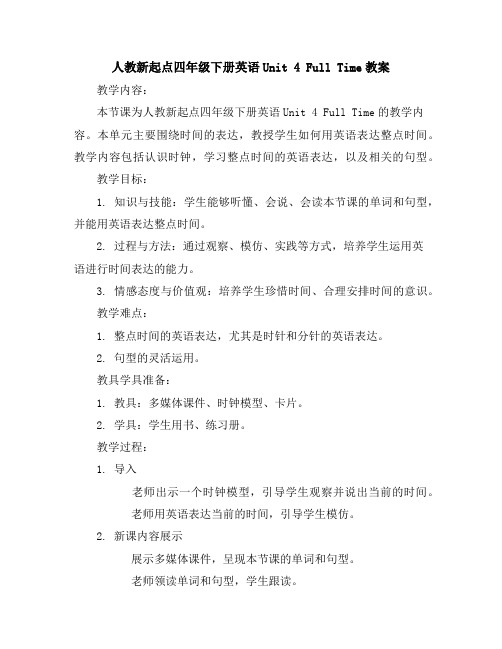
人教新起点四年级下册英语Unit 4 Full Time教案教学内容:本节课为人教新起点四年级下册英语Unit 4 Full Time的教学内容。
本单元主要围绕时间的表达,教授学生如何用英语表达整点时间。
教学内容包括认识时钟,学习整点时间的英语表达,以及相关的句型。
教学目标:1. 知识与技能:学生能够听懂、会说、会读本节课的单词和句型,并能用英语表达整点时间。
2. 过程与方法:通过观察、模仿、实践等方式,培养学生运用英语进行时间表达的能力。
3. 情感态度与价值观:培养学生珍惜时间、合理安排时间的意识。
教学难点:1. 整点时间的英语表达,尤其是时针和分针的英语表达。
2. 句型的灵活运用。
教具学具准备:1. 教具:多媒体课件、时钟模型、卡片。
2. 学具:学生用书、练习册。
教学过程:1. 导入老师出示一个时钟模型,引导学生观察并说出当前的时间。
老师用英语表达当前的时间,引导学生模仿。
2. 新课内容展示展示多媒体课件,呈现本节课的单词和句型。
老师领读单词和句型,学生跟读。
3. 模拟实践学生分组,每组一个时钟模型,进行时间表达的模拟实践。
老师巡回指导,纠正发音和表达错误。
4. 小游戏进行“我说你猜”的游戏,巩固时间表达。
老师说一个时间,学生用英语表达出来。
布置作业:完成练习册的相关练习。
板书设计:1. 本节课的Unit 4 Full Time2. 重点单词和句型作业设计:1. 完成练习册的相关练习。
2. 用英语表达家里的作息时间。
课后反思:本节课通过多媒体课件、时钟模型等教具,生动形象地展示了时间的表达。
在教学过程中,注重学生的参与和实践,通过模拟实践和游戏环节,使学生更好地掌握了本节课的知识。
但在教学过程中,也发现部分学生对时针和分针的英语表达不够熟练,需要在今后的教学中加强练习。
总体来说,本节课达到了预期的教学目标,学生能够用英语表达整点时间。
重点关注的细节:教学难点1. 整点时间的英语表达:表示整点时,使用“o'clock”这个词,例如:7 o'clock表示7点整。
四基教案Unit4 Time
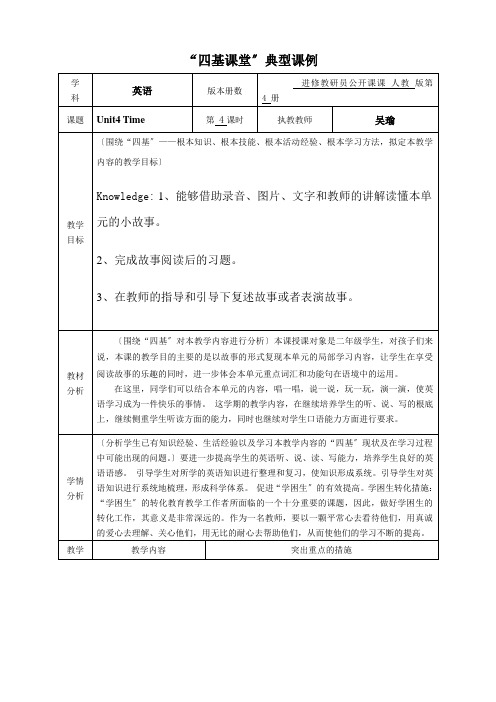
“四基课堂〞典型课例step1 . Warmi ng–upStep2 . Learn the text.Step3 Quest ionsStep4Prese ntatio n 一、greetings二、Let’s chant.三、Review :Whattime is it? It’s……四、故事学习:1、看图提问:2、学生带着问题看课文视频:学生答复下列问题。
3、分局部学习课文故事,第一局部:图1.出示图1,师领读,学生跟读。
学生看图答复下列问题:4、分局部学习课文故事,第二局部Let’s read Picture2、3、4。
学生跟读,理解大意。
自读图2、图3、图4学生答复下列问题:5、分局部学习课文故事,第三局部Let’s read picture5、6.学生跟读,理解大意。
6Listen ,imitate,andread the story.7、学生做课后反应习题.8、Role play.9、What do youlearn from thestory? (你从故事到了什么?〕10、Expand thecontent(拓展内容〕一、Greetings二、Let’s chant.三、Review :学生认读时钟,复习句型:What time is it? It’s……四、故事学习:1、看图提问:Who arethey? Where are they?2、学生带着问题看课文视频: Who arerunning the race?(谁在进行跑步比赛?〕Who win the race?〔谁赢了比赛?〕学生答复下列问题。
3、分局部学习课文故事,第一局部:图1.出示图1,师领读,学生跟读。
学生看图答复下列问题:Who are they?Whattime is it?What do they want to do ?Arethey happy?4、分局部学习课文故事,第二局部Let’sread Picture2、3、4。
小学英语——Unit4Freetime教学设计
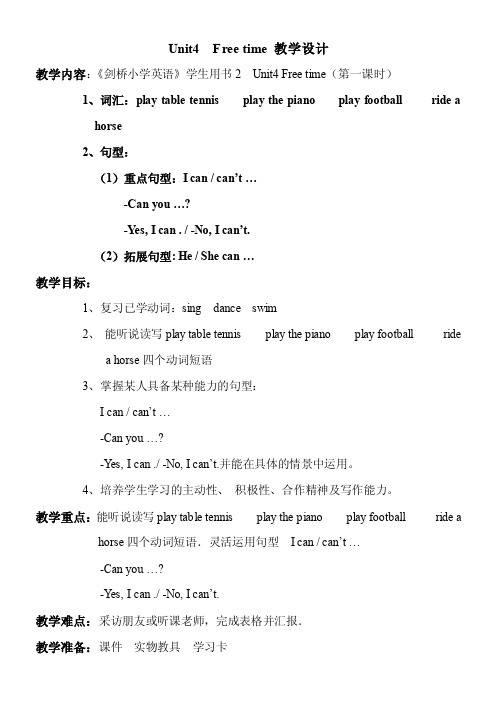
Unit4 Free time 教学设计教学内容:《剑桥小学英语》学生用书2 Unit4 Free time(第一课时)1、词汇:play table tennis play the piano play football ride ahorse2、句型:(1)重点句型:I can / can’t …-Can you …?-Y es, I can . / -No, I can’t.(2)拓展句型: He / She can …教学目标:1、复习已学动词:sing dance swim2、能听说读写play table tennis play the piano play football ridea horse四个动词短语3、掌握某人具备某种能力的句型:I can / can’t …-Can you …?-Y es, I can ./ -No, I can’t.并能在具体的情景中运用。
4、培养学生学习的主动性、积极性、合作精神及写作能力。
教学重点:能听说读写play table tennis play the piano play football ride a horse四个动词短语.灵活运用句型I can / can’t …-Can you …?-Y es, I can ./ -No, I can’t.教学难点:采访朋友或听课老师,完成表格并汇报.教学准备:课件实物教具学习卡教学过程:Step1 warming upGreetings and free talk.T: Boys and girls, I like singing, and I can sing the song “Little star” . (师唱)T: Can you sing this song ?Ss: No.T: Can you sing the numbers song ? (课件呈现歌词)Ss: Y es.T: Good. Now let’s sing it together. (师生齐唱The numbers song)Step2 Presentation and practice(1)教句型I can / can’t …T:I can sing . I can swim. But I can’t dance. (板书、领读I can / can’t …)What about you? (问几名学生) What can you do?T: Now talk about what you can do and what you can’t do with your partner.(学生同桌练习,然后让两组学生起来对话。
- 1、下载文档前请自行甄别文档内容的完整性,平台不提供额外的编辑、内容补充、找答案等附加服务。
- 2、"仅部分预览"的文档,不可在线预览部分如存在完整性等问题,可反馈申请退款(可完整预览的文档不适用该条件!)。
- 3、如文档侵犯您的权益,请联系客服反馈,我们会尽快为您处理(人工客服工作时间:9:00-18:30)。
语文版中职英语基础模块上册 Unit 4 Time 教学设计Unit 4 Time一、Teaching Objectives1. Knowledge ObjectivesMake the students master the following key words and useful expressions. (1). Important Wordsbecause hear problem answer enough leave computer game suddenly remember hurry hour late find talk busy angry table ticket minute news homework(2). Useful expressionsget to in the morning look forward to get up in great joy hurry to talk with be busy with be delighted to…2. Ability Objectives通过学习,学生能够自由运用所学的词组,更好的表达时间。
3. 情感目标通过团队合作来更好的学习知识,学会合作。
知道时间的重要性,珍惜时间,养成遵守时间的好习惯。
(1). To train students sense of cooperation.(2). To learn the important of the time二、 Teaching Important and Difficult Points1 Important Points重点词句的翻译1)I had enough time to do something before leaving for the airport.2) It was lunch time when I got home.3) I was too ashamed to say a word.固定搭配词组的使用1) Look forward to 2) get to 3) in great joy 4) hurry to 5) too…to 6) be busy with2 Difficult Points理解课文,并掌握知识点,并把知识点运用到实际做题当中三、Teaching Methods小组合作、竞赛法四、Teaching AidsA blackboard and a computer for multimedia五、Teaching ProcessStep1 Revision时间的表示法:1、直接表达法2、用基础词按钟点+分钟的顺序直接写出时间(非整点),后面不加O’clock 如:六点四十 six forty3、如果分钟数少于30分钟,可用分钟+past+钟点表示,其中past是介词,意思是“过” 例如四点二十五 twenty-five past four如果分钟数多于30分钟,可用(60分钟-原分钟数)+to +(原钟点数+1)表示,其中to是介词,意思是“差”。
如八点三十五 twenty-five to nine Step2 Warming-upHave you got some gifts about the watch from friends or parents?Step3 ListeningListening to the text and ask the students to know the general idea of the text. Step4 Read the textAsk the students to read the text by themselves with some questions.1. What time should the boy get to the airport?2. How did the boy feel when he heard his grandfather would come?3. What did the boy do before leaving for the airport?4. Did the boy get to the airport on time?5. When did the boy get home?6. How did his grandpa come to the boy’s home from the airport?7. What gift did his grandpa give him?8. What will the boy learn about the watch?Step5 Check the answers.1. He should get up to the airport before nine thirty in the morning.2. He felt very glad.3. He played computer games online with his e-pal.4. No, he didn’t.5. He got home after lunch time.6. His grandpa took his home from the airport.7. An old watch.8. He will learn,” No matter what to do, just do it in time.”Step6 Read it again and ask the students to find out the important points of the text. And the teacher will explain for the student.Language Points:1) Your grandpa is coming by plane tomorrow to see us.现在进行时形式表示即将发生的动作。
常见动词有:come,go,leave等。
例如:My father is leaving for Shanghai tomorrow. 我父亲明天要去上海。
by plane“乘飞机” by bus“乘公共汽车” by bike “骑自行车”2) Will you please get to the airport at nine thirty in the morning to meetyour grandpa on time?Will you please …\Would you please…?委婉地向对方提出要求,请你……好吗?例如:Willyou please open the door? 请你把门打开好吗? On time “准时” 例如:Can you get up on time?你能按时起床吗?3) I was very glad to hear this because I was looking forward to seeingmy grandpa.look forward to “渴望……,盼望……”例如:I am looking forward to hearing from you.我盼望着你的来信。
look forward to 中to 是介词。
其后必须用名词或动名词。
常见类似的动词短语有:be use to (习惯于)stick to(坚持) pay attention to(注意)object to (反对)4) I had enough time to do something before leaving for the airport. Leave for “动身前往……”5) I was too ashamed to say a word.too….to 太…以至于不能……”例如:This question is too difficult to learn.这个问题太难了回答不了。
6) When we were playing in great joy, I suddenly remembered mygrandpa.in great joy“兴致勃勃”例如: When we were talking loudly in great joy, our teacher stopped us.当我们正兴致勃勃高谈时,我们老师制止了我们。
7)I hurried to the airport, but I was two hours late.hurry to… “急忙赶往……” be +时间长度+late “迟到了……时间”例如:I was ten minutes late for class this morning.我今天上午上课迟到了十分钟。
Step7 Retell the text and fill in the blanks.1. One day, my father told me that my grandpa was _______ us _____ the next day.2.My father said to me, “Will you please get to the airport at _________ in the morning to meet your grandpa_________?”3.I was very glad to this because I was ______________________________ my grandpa.4.I had enough time to do something before leaving for the airport because _____________.5.I suddenly remembered my grandpa when _____________.6.I hurried to the airport, but I was __________________.7.When I got home, I found my grandpa was _________ at home.8.My father was very angry because ________________.9.My grandpa ___________ to come home from the airport because he found nobody meeting him there.10.I will remember that _______________________________.Step8 Do some exerciseComplete the following sentences with the correct from of the words or expressions in the box.On time look forward to leave for already onlinein great joy too… to be busy with be late for1. Please come________.2. It is_______ 9 o’clock. We have to go now.3. The children is young answer these questions.4. I am ________Shanghai tomorrow morning.5. Some students of our class go to school_____ bus every morning.6. We sometimes do shopping _______.7. I_______ seeing you here.8. Look! It’s 8 o’clock now. You _______again.9. I was playing the computer games with my brother________.10. We_______ learning English every day.Step9 SummaryStep10 Homeweok。
